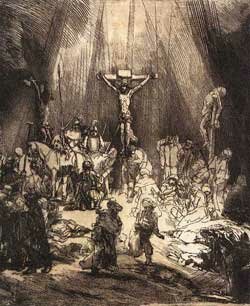St. Florian celebrates the Stations of the Cross
every Friday at 3:00 pm during Lent.
All are welcome to attend.
Go to the online Stations
What are the Stations?
The object of the Stations is to help the faithful to make, in spirit, as it were, a pilgrimage to the chief scenes of Christ's sufferings and death, and this has become one of the most popular of Catholic devotions. The Stations typically cover the sufferings of Jesus along the Via Dolorosa, or the road he takes from condemnation to Golgotha. It is carried out by passing from Station to Station, with certain prayers at each and devout meditation on the various incidents in turn. It is very usual, when the devotion is performed publicly, to sing a stanza of the Stabat Mater, or some other song, while passing from one Station to the next. The Stations of the Cross constitute a major devotion in the Catholic World. They surround the various Sacred places which were personally sanctified by the sufferings and death of our Divine Savior.
How many Stations?
We currently celebrate fourteen Stations of the Cross, however throughout history this number has changed as had the Stations themselves. At one time there was as many as thrirty-seven stations and as few as eight. An account from the middle of the 15th Century fixes the number at fourteen, however only five of the current traditional stations are among these fourteen! As late as 1799, in Vienna, a set of eleven stations was practiced.
Currently two Stations are popular among Catholics. The Traditional Stations where Jesus meets Veronica at the sixth station, and a more Scripture based stations which was first celebrated in public in 1991 by Pope John Paul II.
Like the eleven stations depicted in Vienna, the stations celebrated by Pope John Paul II include events that begin in the Garden and do not occur along the Via Dolorosa, thus covering the entire Passion of Our Lord starting just after the Last Supper.
How many times does Christ Falls?
At one time Christ fell as many as seven times during the Stations of the Cross(as depicted by Krafft at Nuremburg). In the traditional Stations today, he falls three times.
This pious practice once took place in such places as the The Via Dolorosa in Jerusalem and other such sites. Gradually it became universal as several Popes granted plenary and partial indulgences to the faithful who devoutly meditate on the Way of the Cross. Indulgences are:

